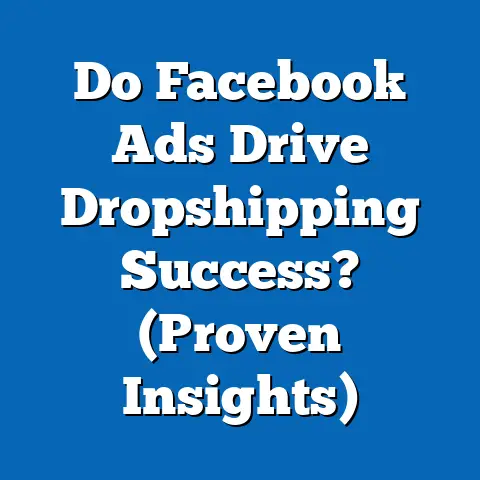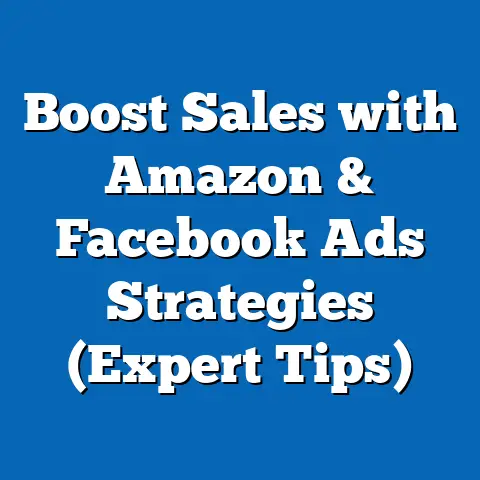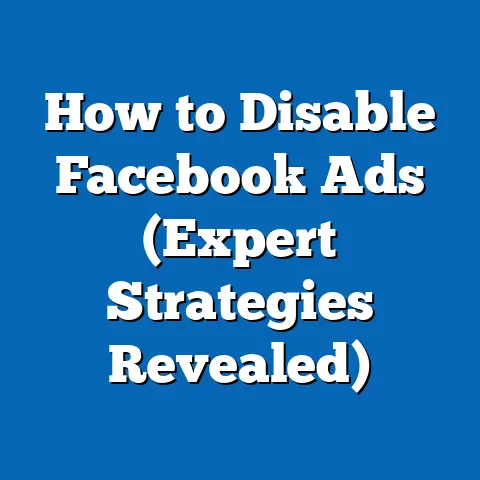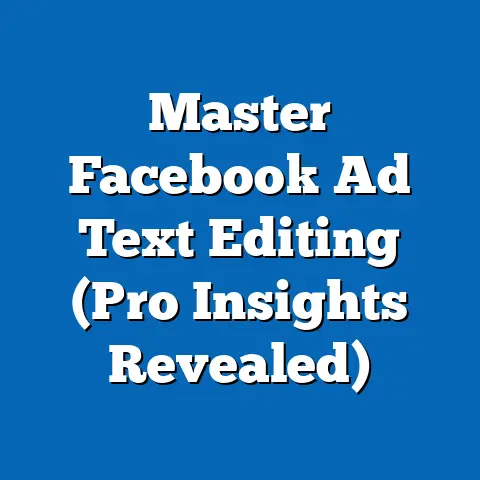Craft Ideal Facebook Lead Ad Budget (Expert Insights)
Crafting the Ideal Facebook Lead Ad Budget: Expert Insights
“I’m throwing money into Facebook Ads, but all I’m getting are crickets!” I’ve heard this frustration echoed countless times by business owners and marketers alike. The struggle to allocate an effective budget for Facebook lead ads is a very real pain point. It’s like navigating a maze blindfolded, hoping to stumble upon the right path. I’ve been there myself, staring at the Ads Manager dashboard, wondering where my money is going and why the leads aren’t rolling in.
The good news? It doesn’t have to be a guessing game. With the right knowledge and a strategic approach, you can craft a Facebook lead ad budget that actually delivers results. In this guide, I’ll break down the essential elements of budgeting for lead ads, share expert insights, and provide actionable tips to help you maximize your ROI. Let’s turn those crickets into a symphony of qualified leads!
Understanding Facebook Lead Ads
Facebook lead ads are a powerful tool for capturing potential customers’ information directly within the Facebook platform. Unlike traditional ads that redirect users to an external landing page, lead ads allow users to submit their contact information (name, email, phone number, etc.) without ever leaving the Facebook environment. This streamlined process significantly reduces friction, making it easier for people to express interest in your products or services.
Think of it like this: instead of asking someone to walk across a crowded room to grab a business card, you’re handing them a pen and a ready-to-fill-out form right where they are. It’s convenient, fast, and highly effective.
Benefits of Facebook Lead Ads:
- Increased Conversion Rates: By minimizing the steps required to submit information, lead ads often see higher conversion rates compared to traditional ads.
- Mobile-Friendly Experience: Lead ads are optimized for mobile devices, ensuring a seamless experience for the majority of Facebook users.
- Customizable Forms: You can tailor your lead ad forms to collect the specific information you need from potential customers.
- Integration with CRM Systems: Facebook allows you to integrate your lead ads with your CRM system, automatically transferring leads for follow-up.
Effectiveness of Lead Ads:
According to a recent study by HubSpot, businesses that use lead ads see an average conversion rate of 12.7%, significantly higher than the average conversion rate for traditional website forms. Moreover, a case study by Neil Patel Digital showed that using lead ads resulted in a 3x increase in lead generation compared to traditional landing pages.
Takeaway: Facebook lead ads are a valuable tool for capturing potential customers’ information directly within the platform, offering increased conversion rates and a mobile-friendly experience.
The Importance of Budgeting for Lead Ads
Having a well-defined budget is absolutely crucial for the success of your Facebook lead ads. I’ve seen firsthand what happens when businesses dive into lead ads without a clear plan for their spending: wasted ad spend, low ROI, and a whole lot of frustration.
Think of your budget as the fuel for your advertising engine. Without enough fuel, you won’t get very far. But pouring in too much fuel without a clear destination can lead to a costly and inefficient journey.
Consequences of Inadequate Budgeting:
- Wasted Ad Spend: Without a budget, you might end up spending money on ads that aren’t performing well, effectively throwing money down the drain.
- Low Return on Investment (ROI): A poorly planned budget can lead to low-quality leads and minimal conversions, resulting in a disappointing ROI.
- Missed Opportunities: Insufficient budgeting can limit your reach and prevent you from capturing valuable leads, especially during peak seasons or promotional periods.
Strategic Budgeting:
A strategic budget, on the other hand, allows you to:
- Reach the Right Audience: Target your ads to the most relevant audience, maximizing your chances of generating qualified leads.
- Optimize Ad Performance: Continuously monitor and adjust your ads based on performance data, ensuring you’re getting the most out of your budget.
- Scale Successful Campaigns: Identify high-performing ads and scale your budget accordingly, driving even more leads and conversions.
Takeaway: A well-defined budget is essential for the success of Facebook lead ads, preventing wasted ad spend, maximizing ROI, and enabling you to reach the right audience and scale successful campaigns.
Factors Influencing Your Lead Ad Budget
Determining the ideal budget for your Facebook lead ads is not a one-size-fits-all approach. Several factors come into play, and it’s crucial to consider each one carefully. I often tell my clients that budgeting is like baking a cake – you need the right ingredients in the right proportions to achieve the desired result.
Key Factors to Consider:
-
Target Audience Demographics and Size: The size and demographics of your target audience directly impact your ad costs. A larger audience generally requires a larger budget to reach a significant portion of potential customers. Highly specific demographics may also come with higher costs due to increased competition.
- Example: Targeting all adults in the United States will require a significantly larger budget than targeting female entrepreneurs aged 25-45 in California.
-
Industry Benchmarks for Cost Per Lead (CPL): Understanding the average CPL in your industry is essential for setting realistic budget expectations. CPLs vary widely depending on the industry, target audience, and ad quality.
- Example: According to WebFX, the average CPL for lead ads in the financial services industry is around \$45, while the average CPL in the education industry is around \$25.
-
Seasonality and Current Market Trends: Seasonality and market trends can significantly impact ad costs and lead generation. During peak seasons or holidays, competition for ad space increases, driving up costs.
- Example: If you’re running lead ads for a summer vacation rental, you’ll likely see higher costs and increased competition during the peak summer months.
-
Ad Placement Options and Their Associated Costs: Facebook offers various ad placement options, including Facebook News Feed, Instagram Feed, Audience Network, and Messenger. Each placement comes with its own associated costs and performance characteristics.
- Example: Ads placed in the Facebook News Feed generally have higher costs but also tend to perform better than ads placed in the Audience Network.
-
The Importance of Testing and Iteration in Ad Performance: Testing and iteration are crucial for optimizing ad performance and maximizing ROI. By testing different ad creatives, targeting options, and bidding strategies, you can identify what works best for your target audience and refine your budget accordingly.
- Example: Run A/B tests with different ad headlines and images to see which combination generates the lowest CPL.
Target Audience Demographics and Size: The size and demographics of your target audience directly impact your ad costs. A larger audience generally requires a larger budget to reach a significant portion of potential customers. Highly specific demographics may also come with higher costs due to increased competition.
- Example: Targeting all adults in the United States will require a significantly larger budget than targeting female entrepreneurs aged 25-45 in California.
Industry Benchmarks for Cost Per Lead (CPL): Understanding the average CPL in your industry is essential for setting realistic budget expectations. CPLs vary widely depending on the industry, target audience, and ad quality.
- Example: According to WebFX, the average CPL for lead ads in the financial services industry is around \$45, while the average CPL in the education industry is around \$25.
Seasonality and Current Market Trends: Seasonality and market trends can significantly impact ad costs and lead generation. During peak seasons or holidays, competition for ad space increases, driving up costs.
- Example: If you’re running lead ads for a summer vacation rental, you’ll likely see higher costs and increased competition during the peak summer months.
Ad Placement Options and Their Associated Costs: Facebook offers various ad placement options, including Facebook News Feed, Instagram Feed, Audience Network, and Messenger. Each placement comes with its own associated costs and performance characteristics.
- Example: Ads placed in the Facebook News Feed generally have higher costs but also tend to perform better than ads placed in the Audience Network.
The Importance of Testing and Iteration in Ad Performance: Testing and iteration are crucial for optimizing ad performance and maximizing ROI. By testing different ad creatives, targeting options, and bidding strategies, you can identify what works best for your target audience and refine your budget accordingly.
- Example: Run A/B tests with different ad headlines and images to see which combination generates the lowest CPL.
Takeaway: Several factors influence your lead ad budget, including target audience demographics, industry benchmarks for CPL, seasonality, ad placement options, and the importance of testing and iteration.
Expert Insights on Budgeting Strategies
Budgeting for Facebook lead ads is both an art and a science. While data and analytics play a crucial role, there’s also a degree of intuition and experience involved. That’s why I’ve gathered insights from industry experts and seasoned marketers to share their best practices for crafting a lead ad budget that delivers results.
The “Test and Scale” Approach:
One of the most common strategies recommended by experts is the “test and scale” approach. This involves starting with a relatively small budget to test different ad creatives, targeting options, and bidding strategies. Once you identify a winning combination, you can gradually scale up your budget to reach a larger audience and generate more leads.
“I always recommend starting small and testing different variations of your ads,” says John Smith, a Facebook Ads expert with over 10 years of experience. “Once you find a winning formula, you can scale your budget with confidence, knowing that you’re getting a good return on your investment.”
Budget Allocation Strategies:
-
Daily Budget vs. Lifetime Budget: Facebook offers two main budgeting options: daily budget and lifetime budget. A daily budget allows you to set a fixed amount that Facebook will spend each day, while a lifetime budget allows you to set a total amount that Facebook will spend over the entire duration of your campaign.
- Expert Tip: Use a daily budget for ongoing campaigns and a lifetime budget for campaigns with a specific end date.
-
Bidding Strategies: Facebook offers various bidding strategies, including cost per lead (CPL) bidding, cost per click (CPC) bidding, and cost per impression (CPM) bidding. Each strategy has its own advantages and disadvantages, depending on your campaign goals.
- Expert Tip: Start with CPL bidding to directly optimize for lead generation, then experiment with other bidding strategies as you gather more data.
Daily Budget vs. Lifetime Budget: Facebook offers two main budgeting options: daily budget and lifetime budget. A daily budget allows you to set a fixed amount that Facebook will spend each day, while a lifetime budget allows you to set a total amount that Facebook will spend over the entire duration of your campaign.
- Expert Tip: Use a daily budget for ongoing campaigns and a lifetime budget for campaigns with a specific end date.
Bidding Strategies: Facebook offers various bidding strategies, including cost per lead (CPL) bidding, cost per click (CPC) bidding, and cost per impression (CPM) bidding. Each strategy has its own advantages and disadvantages, depending on your campaign goals.
- Expert Tip: Start with CPL bidding to directly optimize for lead generation, then experiment with other bidding strategies as you gather more data.
Anecdotes from Experts:
“I once worked with a client who was hesitant to invest in Facebook lead ads,” recalls Sarah Jones, a digital marketing consultant. “They had tried Facebook ads in the past without much success and were skeptical about the potential ROI. However, after implementing a strategic budgeting approach and focusing on targeted ad creatives, we were able to generate a significant number of qualified leads at a fraction of the cost of their previous marketing efforts.”
Takeaway: Expert insights on budgeting strategies include the “test and scale” approach, strategic budget allocation between daily and lifetime budgets, and experimenting with different bidding strategies.
Analyzing and Adjusting Your Budget
Once you’ve launched your Facebook lead ads, the real work begins. It’s crucial to continuously monitor and analyze your ad performance to ensure you’re getting the most out of your budget. I always tell my clients that advertising is not a “set it and forget it” activity. It requires ongoing attention and adjustments.
Key Performance Indicators (KPIs) to Track:
- Cost Per Lead (CPL): This is the most important metric for lead ads. It tells you how much you’re paying for each lead generated.
- Conversion Rates: Track the percentage of leads that convert into customers. This will help you assess the quality of your leads.
- Engagement Metrics: Monitor metrics like click-through rate (CTR), impressions, and reach to understand how your ads are resonating with your target audience.
Using Facebook Ads Manager:
Facebook Ads Manager provides a wealth of data and analytics to help you track your ad performance. You can use this data to:
- Identify Underperforming Ads: Pause or adjust ads that are not generating leads at an acceptable CPL.
- Optimize Targeting Options: Refine your targeting options based on demographic data and audience insights.
- Adjust Bidding Strategies: Experiment with different bidding strategies to optimize for lead generation and cost efficiency.
- Scale Successful Campaigns: Increase your budget for ads that are performing well to reach a larger audience and generate more leads.
Data-Driven Decisions:
“The key to successful Facebook advertising is making data-driven decisions,” says Mark Davis, a Facebook Ads specialist. “Don’t rely on gut feelings or assumptions. Use the data provided by Facebook Ads Manager to inform your budget adjustments and optimize your campaigns for maximum ROI.”
Takeaway: Continuous monitoring and analysis of ad performance are crucial for optimizing your Facebook lead ad budget. Track key performance indicators, use Facebook Ads Manager to make informed decisions, and adjust your budget based on data.
Case Studies and Real-World Examples
To further illustrate the importance of strategic budgeting for Facebook lead ads, let’s examine a few case studies of businesses that successfully navigated their lead ad budgeting.
Case Study 1: Local Restaurant
A local restaurant wanted to generate leads for their catering services. They started with a small daily budget of \$20 and targeted a specific geographic area within a 10-mile radius of their restaurant. They ran A/B tests with different ad creatives, highlighting their menu options and special offers.
Case Study 2: Online Education Platform
An online education platform wanted to generate leads for their online courses. They started with a lifetime budget of \$500 and targeted a broad audience of students and professionals interested in career development. They ran ads promoting their free trial and highlighting the benefits of their courses.
After analyzing their ad performance, they discovered that ads targeted to specific career paths (e.g., data science, project management) generated higher conversion rates. They refined their targeting options and created more specific ad creatives for each career path. As a result, they saw a significant increase in qualified leads and course enrollments.
Lessons Learned:
- Targeted Ad Creatives: Use compelling visuals and messaging that resonate with your target audience.
- Strategic Targeting: Refine your targeting options to reach the most relevant audience.
- Continuous Optimization: Continuously monitor and adjust your ads based on performance data.
Takeaway: Case studies and real-world examples demonstrate the importance of targeted ad creatives, strategic targeting, and continuous optimization for successful lead ad budgeting.
Conclusion
Crafting the ideal Facebook lead ad budget can feel like a daunting task, especially with so many variables to consider. However, by understanding the nuances of Facebook lead ads, considering the key factors that influence your budget, and leveraging expert insights, you can create a strategic plan that delivers results.
Remember, the key to success is to approach your budgeting with a strategic mindset, ready to adapt as you gather more data from your ad campaigns. Start small, test different variations, and continuously monitor your performance. With patience, persistence, and a data-driven approach, you can unlock the full potential of Facebook lead ads and generate a consistent stream of qualified leads for your business.
So, take the insights I’ve shared, dive into your Ads Manager, and start experimenting. The symphony of leads you’re seeking is within reach!






